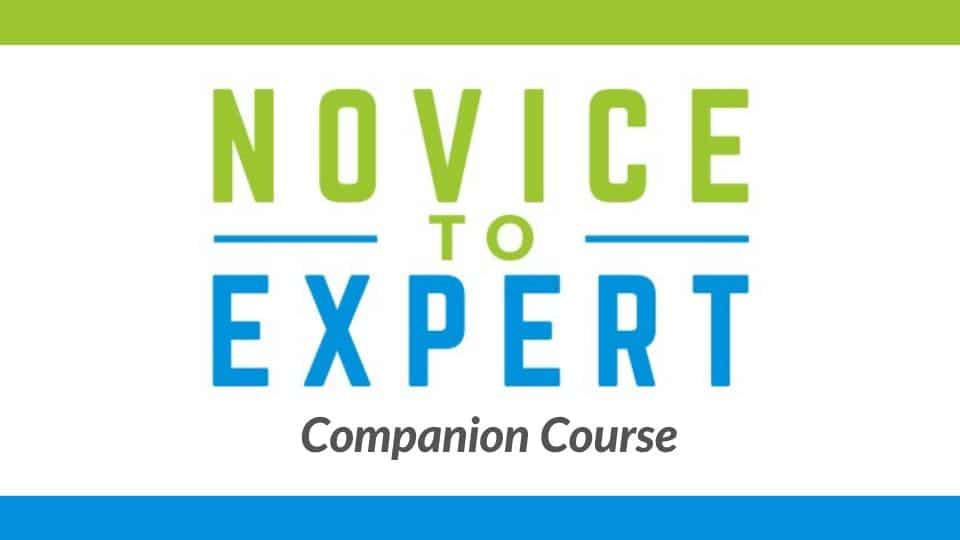We’ve covered a wealth of information in the Novice to Expert book, but that doesn’t mean your self-educational efforts should end with simply reading. That's why I’ve created this small companion website that includes many resources mentioned throughout Novice To Expert.
Here are just a few things you'll get:
Plus, I will be adding more goodies to this website in the months to come. So, if you’re interested in expanding on what you’ve learned in this book, then be sure to check back in regularly.
147 Websites and Apps to Learn Something New (a 9,000 Word Report)
The Internet has made it possible for every individual to access vital information. Be it music lessons, dancing, reading, writing, photography, or learning problem solving skills, all of this is available. All you need is a PC and an Internet connection and you can plunge yourself into any pool of information you want.
If you want to access a wide variety of useful information in a single place, this article is going to make that feasible. Here is a list of 147 websites that can help you learn almost anything you want.
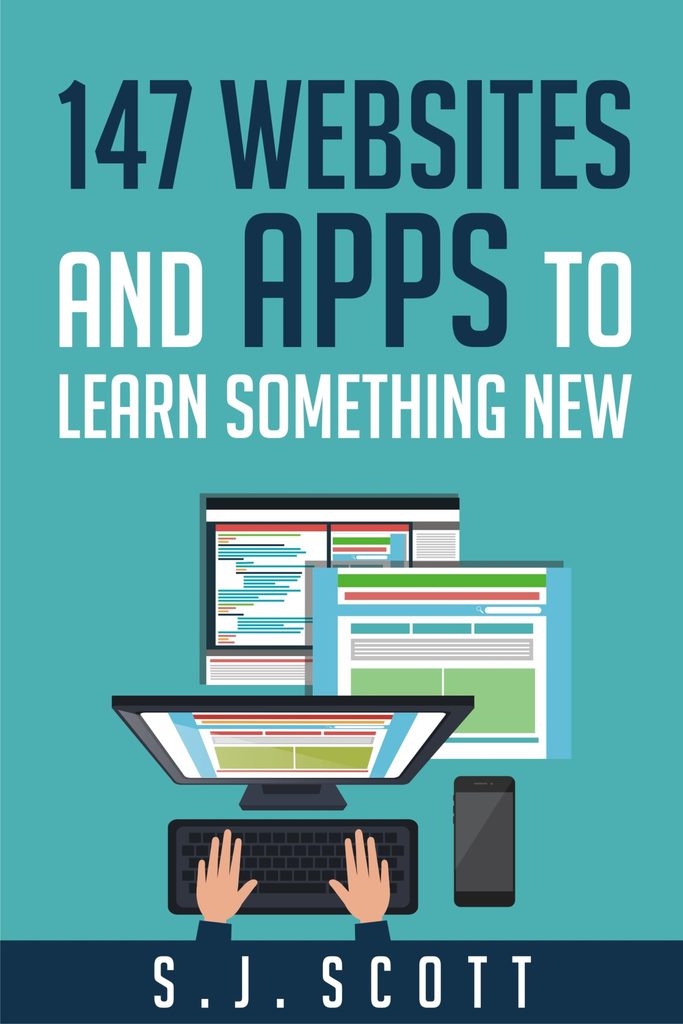
How to Use Evernote for Learning (Walkthrough Video)
Here's how to best use the Evernote app for your self-educational efforts.
How to ToDoist for Learning (Walkthrough Video)
Here's how to best use the Todoist app for your self-educational efforts.
How to Optimize Stitcher for Learning
Here's a quick five-step process to optimize the Stitcher App, so you can listen to the best podcasts related to your skill.
1. Find shows related to your needs. Use the search bar to find matching shows and matching episodes related to your skill.

2. Once you find interesting items, select the “Listen Later” button to add it to your playlist for future reference.
You should also check out an episode or two from each podcast before committing to it. Every podcaster has their own personal style, and you probably have your own preferences. So, don’t be afraid to skip the shows whose style or format you don’t like.

3. Use the “Listen Later” feature. The “Listen Later” option is useful because it allows you to build a collection of your favorite episodes. My advice is to cast a wide net when first browsing shows.
Then, once you find a few you like, add them to your “Favorites Playlist.” This means the app will automatically stream old episodes and post new ones as soon as they are released. Personally, I like to use the “Listen Later” feature because it lists my preferred episodes whenever I fire up the Stitcher app.
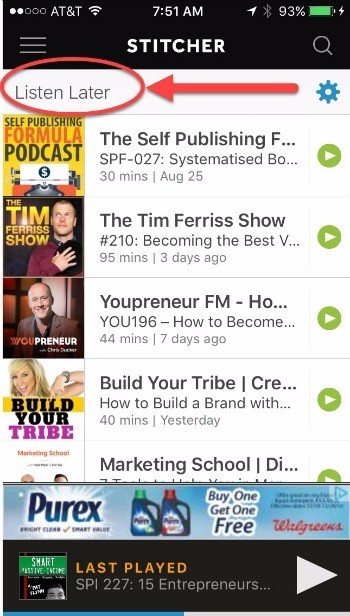
4. Create a two-tiered system. You might feel overwhelmed if you’re subscribed to dozens of shows. It’s an interesting dynamic—you subscribe to these shows to self-educate, but if you miss a few weeks, then you feel anxious because you haven’t “caught up” yet. That’s why I recommend setting up two separate playlists for your shows.
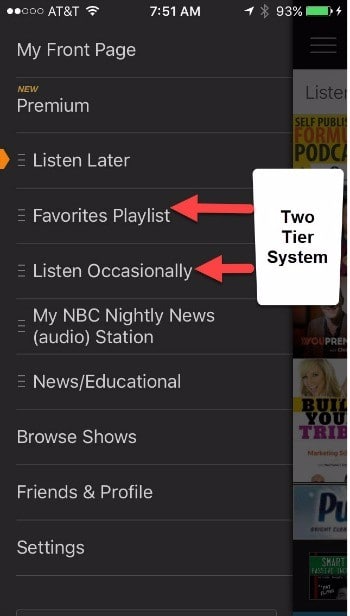
The first playlist includes the can’t-miss shows where you check out every episode. The second playlist (which I call the “listen occasionally” list) includes the shows that sometimes have interesting content. Most of the episodes aren’t directly related to your personal interest, but once in a while there’s an episode you should check out.
This two-tiered system might seem like pointless busywork, but I feel it’s a good strategy if you want to blanket an entire industry, learn as much as you can, and skip the shows that are a waste of your time.
5. Listen at 1.5–2.0 times normal speed. Most podcasts have 10 minutes of useful content surrounded by 20 to 30 minutes of pointless fluff. Sure, it’s good to get a backstory, but if you’re looking to absorb the most information in the shortest amount of time, then you should consider increasing the playback speed to 1.5–2 times the normal speed.
I’ll admit it takes a few days to feel comfortable listening to audio at this speed. Some people (like me) already talk fast, so some recordings might sound like a bad Alvin and the Chipmunks cartoon. Eventually, though, your mind will adapt to the new speed, then you’ll increase the amount you can learn every hour.
Also, take advantage of the skip-ahead feature. Most podcast apps (like Stitcher) include a button that allows you to skip 30 seconds ahead. I recommend using this for the shows with multiple ads or lengthy introductions. Your time is valuable, so you shouldn’t feel guilty if you want to skip ahead to the good stuff.
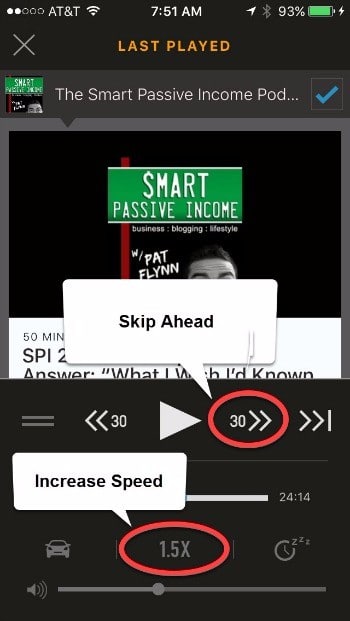
The One-Pager Example of My Self-Publishing Process
Here's an example of the “one-pager” process that I use for my self-publishing business. If you want a detailed explanation of each step, I've also included the PDF that we give to listeners of my Authority Self-Publishing podcast.
The core idea behind this list is to take any repeatable, multi-step process and turn it into a checklist. That way, whenever you have to work on this project, you'll have a paint-by-numbers, list of steps that you can follow. It completely removes the guesswork from any lengthy task that you have to complete.
Here are the 46-steps that I complete for each book:
- Think of a basic book idea.
- Gauge the profit potential of a book idea.
- Dedicate two weeks for brainstorming talking points.
- Identify seven target keywords
- Identify the hook for your book
- Research your topic.
- Do a book “brain dump.”
- Identify your chapters.
- Flesh out each chapter.
- Sort the index cards into a logical order
- Write the outline
- Write the first draft
- Write the second draft
- Finalize the title of the book
- Commission a cover image
- Pick your next book topic
- Polish the third draft
- Send the book to an editor
- Finalize the book cover design
- Review the edits
- Send to a second editor (optional)
- Add the front and back matter
- Send the final version to a book formatter
- Write the sales description for Amazon
- Upload the book to KDP
- Scan on two Kindle devices
- Hire someone to proofread the book
- Format the book for CreateSpace
- Submit the print version to CreateSpace
- Create advertising tracking codes (optional)
- Create redirect links
- Add the book to your author profile
- Schedule your launch date
- Get at least five reviews
- Promote your free offer (optional)
- Contact your personal network
- Leverage other people’s platforms
- Raise your price during the launch (optional)
- Launch your book
- Interact with readers
- Create follow-up campaigns
- Raise your book price
- Evaluate your launch campaign
- Create an audio version
- Take a (small) break
- Start working on your next book
8 Steps for Building a Habit (Short Report)
Novice to Expert Exercises
Exercise #1: Identify Your Learning Style
You can quickly determine your learning style by completing three simple steps.
First, review the seven learning styles discussed in this chapter and look for a description that is familiar. Think back to when you were most engaged with a subject. Ask yourself: How was the information presented? You also want to think about those times when you were completely bored. What caused you to feel disinterested in this topic? Be sure to ask questions like these as you go through the seven learning styles:
- Social (interpersonal)
- Solitary (intrapersonal)
- Visual (spatial)
- Aural (auditory-musical)
- Verbal (linguistic)
- Physical (kinesthetic)
- Logical (mathematical)
Next,narrow down your list to two or three learning styles.As Imentioned before, most people prefer a combination for their self-education.
Finally, if you get stuck or you’re not sure about what learning style works best for you, then you can spend 30 minutes taking this survey: www.learning-styles-online.com/inventory.
Exercise #2: Pick A Skill You’d Like To Master
You can identify the perfect skill for your personal goals by doing the following:
Ask five questions to identify an important area of your life:
- Is there something you want to learn that will improve your health or physical fitness?
- What skill is important for your career development?
- Do you want to pick up a new hobby?
- Are you interested in starting a side business?
- Do you want to improve your financial situation?
Ask eight additional questions to fully understand how much time you can devote to this activity:
- Do you want to build this skill or are others pressuring you to work on it?
- Why is it important to you?
- How much time can you dedicate to this activity?
- What equipment is required for this activity?
- Do you have enough money?
- Is there an immediate deadline for mastering this skill?
- Does this skill relate to your existing value system?
- Do you have the capacity to achieve this goal?
Exercise #3: Build the Learning Habit
There is an abundance of information in the world. In fact, with a little bit of effort, you can find enough resources to help you master any skill.
If you can commit to learning from a variety of multimedia platforms, it’s possible to get hours of daily lessons without it eating up too much of your free time. You can self-educate while driving, exercising, running errands, or relaxing at home. All you need to do is commit to building the learning habit.
To get started, I recommend the following six actions to find the best resources for your chosen skill:
- Buy or borrow top-rated books. Start with a Google search to identify the books most recommended by experts in this industry. Then go to Amazon, a local library, or Audible (if you prefer audiobooks) to grab a copy. (I recommend using the interlibrary system because it’s convenient and free.) If you’re not sure where to get started, you can begin with something in the For Dummies or Complete Idiot’s Guide To series.
- Listen to multiple podcasts. Download the Stitcher app, search for niche-specific podcasts, and listen to a few episodes from each one. When you find a few favorites, use Stitcher to organize them into a playlist that is streamed directly into your queue. Listen to these shows during those pockets of time that would normally be wasted (like driving or running errands).
- Watch video tutorials if you need a demonstration for a technical or mechanical skill. Start with YouTube and look for channels that focus on a single topic. If you need additional instructions, sign up for a course on sites like Lynda, Udemy, CreativeLive, Coursera, edX, or Masterclass. Finally, use TED Talks to expand your thinking on what you’re learning.
- Learn in a real-world setting. Attend classes provided by chain stores, community colleges, or your local library. If you want to quickly achieve mastery, hire a private coach who can get you past those initial roadblocks and challenges.
- Learn online. Read niche-related blogs and interact with others through forums and Facebook groups. Plus, consider starting a podcast if you want to connect with top authorities in your area of expertise.
- Purchase a how-to course. If you feel stuck or simply want a shortcut to learn as much as possible in a short amount of time, this type of course will jumpstart you.
If you leverage these six types of resources, you can surround yourself with quality information that will provide a top-notch educational experience—without spending a lot of your hard-earned money. And since you’ve (hopefully) made the commitment to singularly focus on this topic, you’ll learn at a faster pace than someone who dabbles in this area and fails to take consistent action.
Exercise #4: Take Actionable Notes
There are countless resources for learning a new skill. The challenge here is you need a system for turning information into actionable steps. Otherwise, you’ll spin your wheels in the research phase and never do anything with what you’ve learned. That’s why it’s important to use a note-taking method that focuses on getting results.
Here are a few steps you can do to take action-oriented notes:
- Choose the device you’ll use to record notes (pen and paper, laptop/tablet, or an audio recorder). Just remember that the pen- and-paper approach is the scientifically proven best method for helping people retain the largest amount of information.
- Use the Cornell Method to format the pages in your notebook. Here, you’ll divide each page into three sections that can be used to jot down notes and identify key points along the way.
- Review your notes after each learning session. Here, you will identify important concepts, insert key words into the cues section, and then create a summary of the information at the bottom of each page.
- Turn your notes into a one-pager that will act as a cheat sheet and action guide that you can use to implement the key strategies for your skill. This will act as a simple action plan to use whenever you’re implementing a lengthy process
It doesn’t matter if you self-educate with a video, book, podcast, in a classroom, or by talking to others—if you follow these four steps for your note-taking efforts, you will compress a lot of information in a short amount of time—without feeling overwhelmed.
Exercise #5: Create A Project Around the Skill
You can turn what you’ve learned into a series of tasks by doing the following:
- Create a skill-specific project folder for your skill. Do this inside the Evernote and Todoist apps. Or buy a notebook you’ll dedicate to this project that will always be with you.
- Write down all the tasks that you need to complete. Be sure to include due dates, one-time tasks, resources to check out, and any habits you need to build. If you get stuck with this project list, simply ask: “What’s my next step?” Then schedule it into your calendar.
- Jot down every new lesson learned, potential strategy, or aha moment that comes to mind. Put all of them into a central location that you constantly monitor. This could be in Evernote or in a physical notebook. What you choose isn’t relevant. The important thing is to . . . Write. Down. Everything.
- Focus on just-in-time learning, where you focus on tasks that directly relate to your most current challenge. Work on this area until it’s fully completed, then move on to the next step.
- Build a habit related to your skill. You can use apps like Todoist, Habitica, or Coach.me to reinforce this action.
- Use the two-task rule to work at this skill daily. One task should be a regular habit and the other will be pulled from your project list.
If you have a willingness to carve out time to work on a skill every day, you’ll slowly make that transition from novice to expert!
Exercise #6: Deliberately Practice Every Day
It’s not enough to set aside time to work at a skill. Instead, you should chunk down the process into its smallest components and then work at mastering each one before moving on. You can do this by completing the following eight steps:
- Understand the fundamentals. Practice just-in-time learning to identify the critical components, or get a recommendation (from a coach) for specific drills to focus on.
- Practice (and master) each microcomponent. Your goal is to master each aspect of the skill in one to three sessions. If you can’t master it during this time, then look for a way to further drill down the skill into a smaller component.
- Get immediate feedback from a skill expert. If you can hire a coach, then this will be a worthwhile investment. Otherwise, find videos of someone demonstrating this skill and ask a friend to provide a critique based on what you see.
- Embrace your mistakes. Don’t be afraid to make a mistake during these sessions. Sure, it might not be fun to make errors, but just remember this is an important part of the learning process.
- Slow down your deliberate practice. You don’t need to rush through a skill to master it. In fact, it’s better to go as slowly as possible to understand how it works and then increase your speed as you start to achieve mastery.
- Complete many repetitions. Doing the same thing over and over will build the muscle memory that’s an important part of turning a skill into an unconscious action. In addition, you should consider increasing the difficulty of these practice sessions, so you perform well no matter what comes up.
- Take breaks during your practice session. You’ll find it’s easier to retain information and master a skill by breaking down a session into smaller segments with quick breaks. I recommend the Pomodoro Technique, where you work for 25 minutes, rest for 5, and then work for another 25 minutes. Repeat this process as often as you need.
- Track your success. Record your progress in a journal and be honest about any challenges you’re experiencing. My suggestion is to use a tool like The Freedom Journal.
You have a choice at the start of every new day. Either you choose to waste it by practicing a skill without a clear plan, or you choose to break it down into small components and then master each one. If you follow this action plan for deliberate practice, you will maximize the results you get from each session.
Exercise #7: Overcome Six Habit-Learning Challenges
There are six challenges you might face when learning something new. If you don’t know how to overcome these obstacles, you risk derailing your efforts. That’s why I recommend doing the following to overcome each challenge.
Challenge #1: Procrastination or Difficulty Getting Started
- Define the individual components of the skill and identify the smallest actions you need to take to make forward progress.
- Get an accountability partner that you can meet with on a regular basis and openly talk about your challenges.
- Use if-then statements that will help you take action—even when you feel like skipping a day.
Challenge #2: Finding the Time
- Say no to activities like television, pointless meetings, and any section of the day that you’re wasting.
- Maximize those small 5- to 10-minute pockets of time by consuming information related to your skill and completing small tasks.
- Go to bed 30 minutes earlier and then wake up 30 minutes sooner in the morning. Use this time to work on your skill.
Challenge #3: Sticking With a Skill
- Use the mini habits concept to set small goals that you can achieve every day—even when you don’t have more than a spare five minutes.
- Practice the skill whenever you can.
- Pick one or two of the top-rated (or your favorite) industry-specific podcasts and listen to every new episode.
- Read content from your favorite blogs and forums.
- Teach this concept to others.
- Form a mastermind group.
- Leverage your local Meetup groups.
Challenge #4: Inability to Stay Consistent
- Practice the skill whenever you can.
- Pick one or two of the top-rated (or your favorite) industry-specific podcasts and listen to every new episode.
- Read content from your favorite blogs and forums.
- Teach this concept to others.
- Form a mastermind group.
- Leverage your local Meetup groups.
Challenge #5: Fear of Missing Out (FOMO)
- Identify your top five priorities. Focus your efforts on just these activities.
- Identify your next 20 priorities.
- Make sure that you avoid these 20 activities at all costs unless you’re willing to replace one of your current top five priorities with one of the 20.
Challenge #6: Not Receiving Support
- Pay attention to the concerns of the people in your life and address them by having an open dialogue about their fears.
- Look for signs of emotional abuse and confront this behavior from your significant other.
- Surround yourself with like-minded people who will support your efforts to work on this skill.

